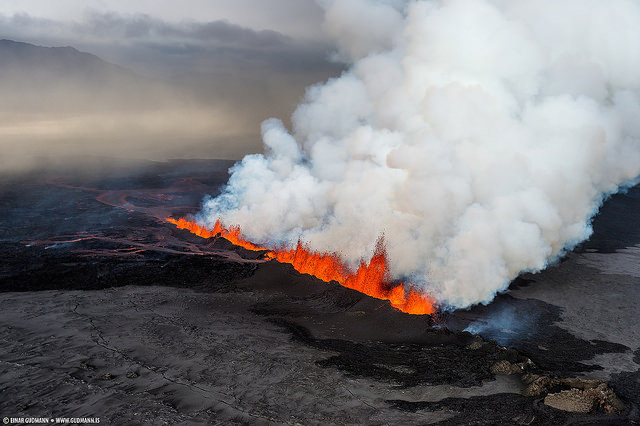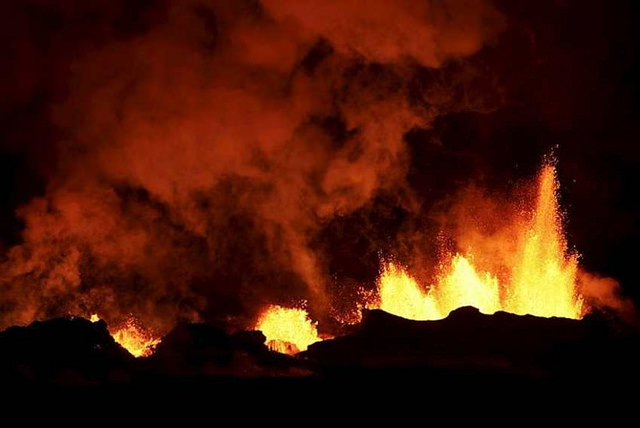Sunny with a hint of poisonous gas. Posted by hulda on Oct 9, 2014 in Icelandic culture, Icelandic customs
The whole capital city region has been engulfed in a sulfur dioxide cloud since Monday, and it seems to go on for at least until the wind changes direction. Yes, the volcanic eruption is still going on. The world may have forgotten it by now but a volcano does not care about whether it’s being watched or not, it has quietly scaled itself on VEI5 level and is now comparable to the eruption of St. Helens (link).
Indeed, these last few days the volcano has been much in the news. An eruption below Vatnajökull is still discussed as a possibility due to the continuing seismic activity and the top of the ice having sunk noticeably, although everyone of course hopes that won’t happen. Last time an eruption occurred below the glacier at Grímsvatn large clouds of ash polluted the drinking water in all of the nearby areas – and an eruption of this scale is not a laughing matter. You can see the area that would be hit the worst here.
As for the sulfur dioxide there’s nothing much that needs to be done while it stays below hazardous levels. People who are in any of the risk groups – elderly, ill or with lung-related problems – are advised to stay indoors as much as possible but for the majority of people life just goes on as normal (link). We’re following the moves of the sulfur dioxide cloud here.
But not all’s bad news about the volcano – Eric Cheng managed to get an amazing view at it! You can see the resulting film and Eric himself explaining some things behind the scenes here. Besides, the sunsets and dawns, though always beautiful, have turned rather unusually so in the last few days (link)(link).
Big horses, big fish, an unkindness of ravens
Another theme for the most recent news have been animals and the weather in general. Icelandic horses, for example, have grown taller. This article mentions that the average height of an Icelandic horse has grown for about 12cm is the last 20 years. Watch out world, they’re catching up in size! 😀
Meanwhile Eysteinn Örn Garðarsson has had some serious fishing luck by catching a cod weighing 50kg! The Atlantic cod can grow to over 90kg at best but this is still one huge fish. Eysteinn himself says that in all his 16 years fishing this is by far the largest that he’s seen. You can have a look at his catch here and compare its size to the man who caught it.
Ravens, though usually well-liked, do have some well-earned enemies: the sheep farmers. The story of how the ravens killed a lamb is a little gory so you may or may not want to read more about it, but what makes this news truly Icelandic is the farmers first reaction when he saw what they had done… he composed a poem about them.
Hrafn á að hengja og skjóta,
höggva, stinga og brjóta.
Það er ekkert rugl,
þetta er andstyggðarfugl,
með söguna svarta og ljóta.
Raven should be hung and shot,
beaten, pierced and broken.
This is not nonsense,
it’s an abominable bird,
with history black and ugly.
And now – the weather
We also had snow (link). People were of course very excited and social media sites were flooded with photos of this strange phenomena, although in all honesty it’s typical for Iceland that you see some snow in early October. It usually won’t last long, but although it happens almost every year it still manages to surprise everyone. 😀
In fact the winter used to fall in much earlier just a few years ago, and the real anomaly has been the general warmth of the most recent ones. As a Finn I’m not going to judge people too harshly though – in my home country people get surprised by the fact that ice is slippery each winter, causing accidents left and right…
But back to Iceland, I’ve been saving the even more typical autumn weather phenomena until last. Have you ever seen a waterfall fall sideways? We do, on what Icelanders describe as slightly breezy days such as this one (there’s also a video of a sideways waterfall in the link). Autumns in Iceland are dark, rainy and windy, storm warnings are the norm and when Icelanders warn about a storm it means business. A storm here can mean winds so strong they strip asphalt off the roads, tear off roofs and topple cars. If, for some reason, you’d like to travel in Iceland during the autumn, keep an eye on weather forecasts. Búist er við stormi (= a storm is expected) in particular is the sentence you want to look out for, especially if it’s followed with ekkert ferðaveður (= no traveling weather/not a good weather for driving around). Even if it goes against your plans, do not drive out of towns and into the countryside on those days. Trust me, it’s a bad, bad idea.
This has been one interesting week in the news in Iceland, let’s hope the nature will settle down a bit by Halloween!

Build vocabulary, practice pronunciation, and more with Transparent Language Online. Available anytime, anywhere, on any device.
About the Author: hulda
Hi, I'm Hulda, originally Finnish but now living in the suburbs of Reykjavík. I'm here to help you in any way I can if you're considering learning Icelandic. Nice to meet you!







Comments:
Mitch Griggs:
Takk Hulda,
I enjoy reading this blog and your entries always get a laugh.
hulda:
@Mitch Griggs Hi Mitch, and welcome! I’m happy you like my blogging, I do love to write about Iceland. 🙂